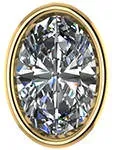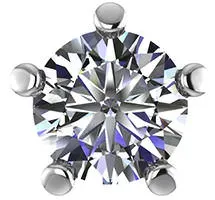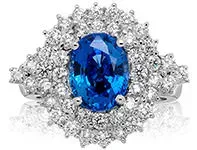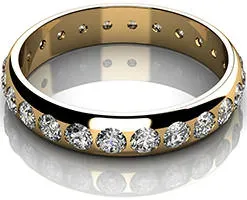 One of the earliest methods of setting gemstones into jewelry. It features a thin band of metal completely surrounding the gem along its circumference. It offers superior protection from chipping, will not snag on clothes, and may even make the gem seem bigger than it really is.
One of the earliest methods of setting gemstones into jewelry. It features a thin band of metal completely surrounding the gem along its circumference. It offers superior protection from chipping, will not snag on clothes, and may even make the gem seem bigger than it really is.
In this modern variation of a Bezel setting, only half of the gemstone is surrounded by a thin band of metal. This setting shows off more of the gemstone by allowing light to illuminate more of the stone, adding to its sparkle, while still maintaining the superior protection offered by the Bezel setting.
 This type of setting refers to metal spikes or claws (prongs) that are curved at the end and hold the gemstone securely in place by gripping it from the top. This type setting is especially popular for round or oval solitaire, or single stone rings. It allows light to come through the top and the sides of the gemstone, minimizing the look of metal and increasing the gemstone's visual appeal. A gemstone may be mounted high or low in a prong setting, and the higher it's set - the more prominent it looks. It may include 3, 4, or 6 prongs per head, which is the center of the setting. The prongs are set either evenly spaced all around the gemstone or at the four corners. One thing to look for is that the prongs are well polished so they don't snag on clothes. Prongs tend to wear out or become loose over time and should be carefully checked every year.
This type of setting refers to metal spikes or claws (prongs) that are curved at the end and hold the gemstone securely in place by gripping it from the top. This type setting is especially popular for round or oval solitaire, or single stone rings. It allows light to come through the top and the sides of the gemstone, minimizing the look of metal and increasing the gemstone's visual appeal. A gemstone may be mounted high or low in a prong setting, and the higher it's set - the more prominent it looks. It may include 3, 4, or 6 prongs per head, which is the center of the setting. The prongs are set either evenly spaced all around the gemstone or at the four corners. One thing to look for is that the prongs are well polished so they don't snag on clothes. Prongs tend to wear out or become loose over time and should be carefully checked every year.
A variation of a standard prong setting that is essential to more angular shapes such as square, pear, heart, marquis or trillion shaped gemstones. V-prongs wrap around the gemstone's edges protecting its delicate corners from chipping. More of the gemstone's surface area is exposed on top, making the gemstone appear bigger and more visible. However, the downside is that the top of the gemstone remains exposed, and the gemstone may more easily slip out of its setting.
In this variation of a prong setting, two gemstones are held together side by side by a common prong. In this way, less metal shows through, allowing more light to pass through the gemstones. This type of setting is most commonly used in eternity bands.
In this setting, two strips of metal hold the gemstones flush with each other with no additional prongs or metal in between them, allowing for a seamless appearance. The setting completely surrounds the gemstones, offering the most protection from chipping and appears smooth, making it impossible to snag on clothes. It is a popular choice for eternity rings, anniversary and wedding bands, where gemstones cover the entire circumference of the ring.
Originated from the French word "paved"" or ""cobblestoned"", this style features a metal band that is encrusted with dozens of tiny gemstones. Those stones are held in place with small prongs or beads, so much so that the metal underneath them is practically invisible. It often appears as a continuous surface of shimmering stones. Round brilliant gemstones are used most often in this type setting because they offer the most sparkle. This setting differs from Channel in that the stones used in Pave are tiny and are held together with prongs, whereas in Channel setting the stones are generally much bigger and are more distinctly set in the metal band. Another version of this setting is Micro-Pave. This is where even smaller gemstones are embedded into a sheet of metal using a microscope. The advantage of Micro-Pave setting is that gemstones can now be set with much more efficiency, accuracy and speed while minimizing the cost of setting all those tiny gemstones by hand."
One of the newer and most difficult setting methods, where gemstones are positioned flush with each other in a metal setting with no metal showing through. This look gives a jewelry item a continuous, seamless appearance. This setting style is used for square (princess) or octagonal (![]() emerald or baguette) shaped gemstones, and occasionally trillions, since they can be positioned extremely close to each other with no spaces showing in between. Gemstones themselves are cut with a groove of their pavilion so that they fit perfectly into the tracks fashioned in the metal band. There are no prongs or beads holding the gemstones in place, like in Pave setting. Due to the damage to the stones, only cheaper gemstones are used in this setting and almost never center stones.
emerald or baguette) shaped gemstones, and occasionally trillions, since they can be positioned extremely close to each other with no spaces showing in between. Gemstones themselves are cut with a groove of their pavilion so that they fit perfectly into the tracks fashioned in the metal band. There are no prongs or beads holding the gemstones in place, like in Pave setting. Due to the damage to the stones, only cheaper gemstones are used in this setting and almost never center stones.
 In this setting a large center stone is surrounded with smaller stones. Alternatively, numerous small gemstones are set with prongs close together to give the illusion of a much larger center stone. This type of setting is especially popular with floral designs and in antique jewelry.
In this setting a large center stone is surrounded with smaller stones. Alternatively, numerous small gemstones are set with prongs close together to give the illusion of a much larger center stone. This type of setting is especially popular with floral designs and in antique jewelry.
 A generic term for a technique of setting a stone into a metal surface using an engraving tool called a setting bur. Tiny holes are drilled into metal and stones are then placed directly into those holes. Then, the metal surrounding the stones is bent all around to form beads that will hold the stones in their positions. Many setting styles use this technique ï¾– when many tiny stones are set close together in a bead setting this is called Pave setting because it creates the look of a paved surface.
A generic term for a technique of setting a stone into a metal surface using an engraving tool called a setting bur. Tiny holes are drilled into metal and stones are then placed directly into those holes. Then, the metal surrounding the stones is bent all around to form beads that will hold the stones in their positions. Many setting styles use this technique ï¾– when many tiny stones are set close together in a bead setting this is called Pave setting because it creates the look of a paved surface.
In this setting multiple gemstones are held together by tiny metal bars which are exposed and aligned perpendicular to the ring band. Unlike in a Channel setting, the sides of the gems remain open creating an unobstructed view of the stones. This allows more light to enter and illuminate the stones, but does offer less protection for the stones. However, due to its unusual visual appeal, this design is popular in tennis bracelets in addition to anniversary and wedding bands.
In this relatively new type of setting tension or metal pressure is used to secure the gemstone in place instead of prongs, beads, or metal bars. The metal in the setting is spring loaded to exert pressure on the gemstone and tiny grooves are etched into the setting enabling the edges of the stone to rest. The gemstone appears to hover in the air without any support. Platinum is usually used in this type of setting because the metal must be strong enough to create sufficient pressure to hold the gemstone in place. The gemstone also must be hard enough for this type of setting so it does not crack under pressure. Usually, sapphires, rubies, moissanite, and diamonds are used, with a hardness of 9 or 10 on the Mohs hardness scale. Rings set using Tension setting can not be resized, because that will remove the spring loading effect. In addition, this type of setting can not be manufactured ahead of time with the stone to be chosen later. That is because the computer calibrates the exact amount of pressure for each given gemstone to make sure not to damage it.
In this setting a band of shiny and highly reflective metal surrounds the girdle of the gemstone, usually a ![]() diamond, to make it appear larger than it really is. Unlike a Bezel set, where the band of metal surrounds the diamond completely, in this setting the diamond is secured in place with prongs and the metal surrounding it is "bright cut"", where tiny metal incisions make it shiny enough to blend in with the diamond, diffusing the silhouette of the diamond. This technique was patented by Van Cleef & Arpels in 1933."
diamond, to make it appear larger than it really is. Unlike a Bezel set, where the band of metal surrounds the diamond completely, in this setting the diamond is secured in place with prongs and the metal surrounding it is "bright cut"", where tiny metal incisions make it shiny enough to blend in with the diamond, diffusing the silhouette of the diamond. This technique was patented by Van Cleef & Arpels in 1933."
In this type of setting diamonds are recessed or embedded deeply into holes drilled within the band of metal, leaving only the table, or the top of the stone visible. Only diamonds are used in this type of setting because a substantial amount of pressure is required to secure the ![]() diamond into its hole. The finished look is smooth and clean and is highly popular in men's rings as well as women's rings.
diamond into its hole. The finished look is smooth and clean and is highly popular in men's rings as well as women's rings.